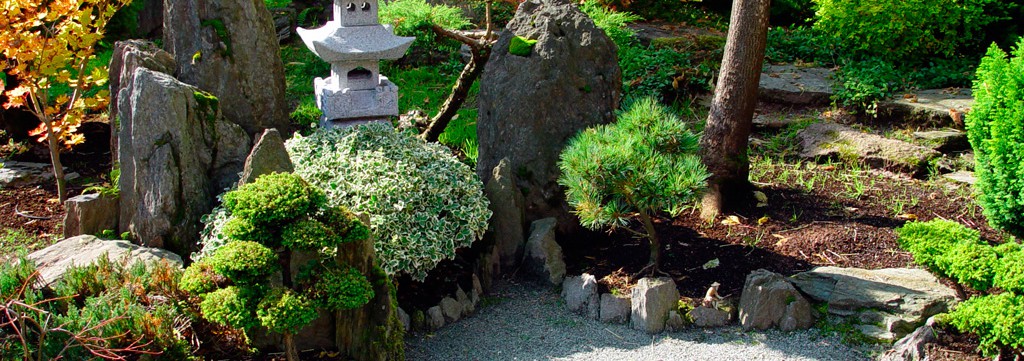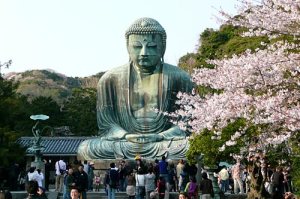 In Zen Buddhism, art practices, like Zen gardens, play a central role in their method of meditation and understanding. The Zen gardens we currently see today began to make an appearance in Japan around the 11th century outside of Buddhist temples. The purpose of the gardens were to provide the monks with a “place to walk and contemplate Buddha’s teachings.” The design of the garden was supposed to promote a feeling of peace and harmony in a space. It has been said that a special group of monks, called “Ishi-tate so (stone-setting priest),” would travel around Japan to set up these gardens, drawing inspiration from “Sung paintings that featured gray, white, and black ink.” By the time the 13th century rolled around, Zen gardens were heavily integrated in Japanese life and culture.
In Zen Buddhism, art practices, like Zen gardens, play a central role in their method of meditation and understanding. The Zen gardens we currently see today began to make an appearance in Japan around the 11th century outside of Buddhist temples. The purpose of the gardens were to provide the monks with a “place to walk and contemplate Buddha’s teachings.” The design of the garden was supposed to promote a feeling of peace and harmony in a space. It has been said that a special group of monks, called “Ishi-tate so (stone-setting priest),” would travel around Japan to set up these gardens, drawing inspiration from “Sung paintings that featured gray, white, and black ink.” By the time the 13th century rolled around, Zen gardens were heavily integrated in Japanese life and culture.
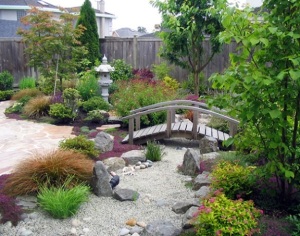 The design behind the Zen garden plays a larger role in what they represent to Zen Buddhists. The sand (or sometimes small pieces of gravel) represents water. As a monk rakes the surface, he is creating the texture of waves, similar to those in an ocean and the larger rocks represent a shore. Some say that this symbolism of an ocean relates to the philosophy about how “everything is caused by something, and in turn, is cause for something else” as something causes the waves and the waves crash to the shore, which can change the sand/rock features. Since the sea is ever-changing, yet consistent, it plays a large role in symbolism to a Zen Buddhist. A Zen garden will also have one stone representing the center of the world. Around this central stone are other small stones representing worship, the Buddha, children, animals, or “tricksters.” When a Zen garden incorporates other natural elements (such as plants, trees, water, fish, etc.), it can illustrate the philosophy that “contradiction is a part of all life (as there are different elements coming together in one place).” If there are shrines in the garden, it usually symbolizes a place where spirit and mankind are coming together. The beauty of these gardens, is that no two gardens are alike. This allows for extreme individual reflection as to how the gardener interprets their world and their Path.
The design behind the Zen garden plays a larger role in what they represent to Zen Buddhists. The sand (or sometimes small pieces of gravel) represents water. As a monk rakes the surface, he is creating the texture of waves, similar to those in an ocean and the larger rocks represent a shore. Some say that this symbolism of an ocean relates to the philosophy about how “everything is caused by something, and in turn, is cause for something else” as something causes the waves and the waves crash to the shore, which can change the sand/rock features. Since the sea is ever-changing, yet consistent, it plays a large role in symbolism to a Zen Buddhist. A Zen garden will also have one stone representing the center of the world. Around this central stone are other small stones representing worship, the Buddha, children, animals, or “tricksters.” When a Zen garden incorporates other natural elements (such as plants, trees, water, fish, etc.), it can illustrate the philosophy that “contradiction is a part of all life (as there are different elements coming together in one place).” If there are shrines in the garden, it usually symbolizes a place where spirit and mankind are coming together. The beauty of these gardens, is that no two gardens are alike. This allows for extreme individual reflection as to how the gardener interprets their world and their Path.
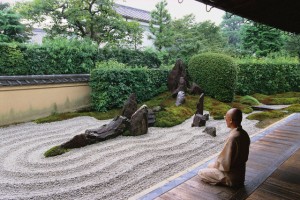 The practice of building and maintaining the garden is to promote meditation, which plays a large role in Zen Buddhism. As the gardener rakes, it gives the mind time to “release, organize, and integrate specific thoughts,” and sometimes it allows for no thoughts at all. Zen gardens are specifically designed to promote relaxation, focus, and peace. The rocks represent an eternal element of nature in a Zen garden. There are five categories of these rocks. “Kikyaku (the element of earth) is a reclining stone that sets near the foreground. Shintai (the element of water) is either horizontal or flat, and is often used as a base stone. Shigyo (the element of fire) arches and sets to the side of other shaped stones. Reisho (the element of metal) is vertical and low-lying, demonstrating the firm nature of metal. Finally the Taido (the element of wood) is a vertical, tall stone implying trees and usually goes to the back of a design so it doesn’t impede the view.” These rocks are important to promoting the intentions of the garden has they each represent powerful symbolism in the religion.
The practice of building and maintaining the garden is to promote meditation, which plays a large role in Zen Buddhism. As the gardener rakes, it gives the mind time to “release, organize, and integrate specific thoughts,” and sometimes it allows for no thoughts at all. Zen gardens are specifically designed to promote relaxation, focus, and peace. The rocks represent an eternal element of nature in a Zen garden. There are five categories of these rocks. “Kikyaku (the element of earth) is a reclining stone that sets near the foreground. Shintai (the element of water) is either horizontal or flat, and is often used as a base stone. Shigyo (the element of fire) arches and sets to the side of other shaped stones. Reisho (the element of metal) is vertical and low-lying, demonstrating the firm nature of metal. Finally the Taido (the element of wood) is a vertical, tall stone implying trees and usually goes to the back of a design so it doesn’t impede the view.” These rocks are important to promoting the intentions of the garden has they each represent powerful symbolism in the religion.
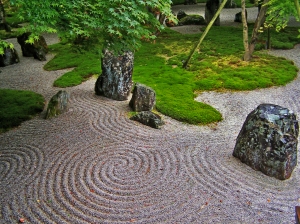 Because they are designed to invoke peace, tranquility, and meditation, it is often up to the viewer of the garden to gather their own personal meaning, which is essentially the beauty of it all. It is a sacred place to meditate on the teachings of Buddha, whatever that may mean to the viewer. Each separate garden will never mean the same thing to the viewer as it did to the gardener. This allows the garden to actually serve its purpose: meditation and thought/reflection. The Zen garden is a large epitome of the how aesthetics play a large role in Zen Buddhism and their practice of meditation (which to them is one of the best ways to further your self-knowledge and understanding).
Because they are designed to invoke peace, tranquility, and meditation, it is often up to the viewer of the garden to gather their own personal meaning, which is essentially the beauty of it all. It is a sacred place to meditate on the teachings of Buddha, whatever that may mean to the viewer. Each separate garden will never mean the same thing to the viewer as it did to the gardener. This allows the garden to actually serve its purpose: meditation and thought/reflection. The Zen garden is a large epitome of the how aesthetics play a large role in Zen Buddhism and their practice of meditation (which to them is one of the best ways to further your self-knowledge and understanding).
Citations for this page:
5/21/04, and Page 83. Stanford Journal of East Asian Affairs The Japanese Garden for the Mind: The ‘Bliss’ of Paradise Transcended (n.d.): 83-102. Stanford University, 21 May 2004. Web. 21 Nov. 2014.
“Historical Japanese Gardens.” Historical Japanese Gardens. Japanese Gardens, 2001. Web. 19 Nov. 2014.
4.
